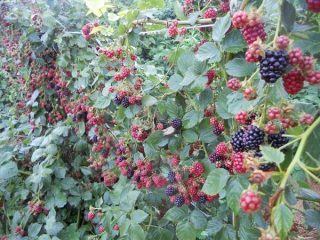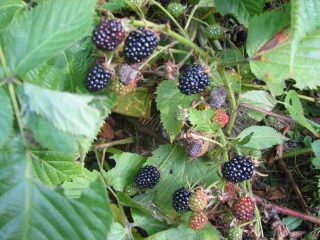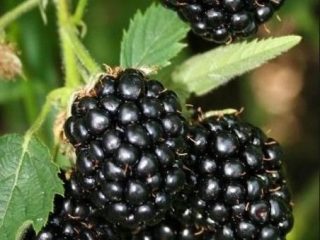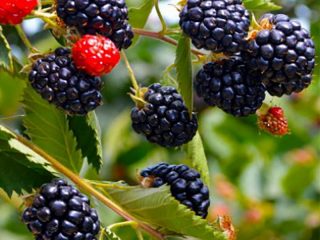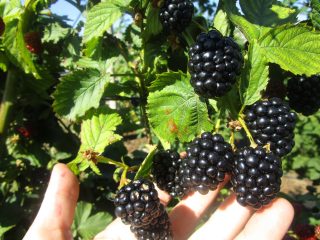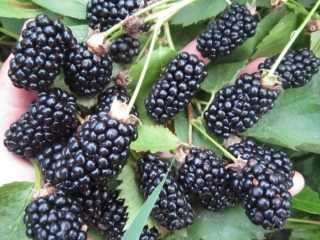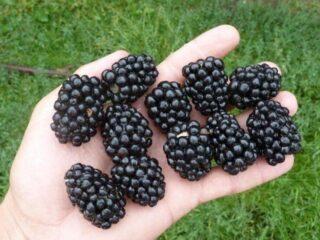Content
Gray blackberry is a representative of the Rosaceae family from the Rubus genus. It is used in gardening, beekeeping, cosmetology, alternative medicine and cooking. The shrub is undemanding in terms of location and care.
Description and characteristics of gray blackberries
Gray blackberry (Rubus caesius) is a biennial shrub. It reaches a height of 0.5-1.5 m. Main characteristics of the perennial:
- one-year-old shoots are cylindrical, smooth or pubescent, yellow-green in color, bristly thorns;
- two-year-old branches are woody and covered with thorns;
- bisexual flowers, 2-3 cm in diameter;
- white, sometimes pink, broadly ellipsoidal petals, green calyxes with pubescence;
- leaves, divided into three lobes, have thorns;
- petiole length 4-7 cm, teeth along the edges, light green color;
- flowering is unfriendly, occurs in July-August.
In blue-gray blackberries, the fruits are formed from a small number of drupes. They are large, there is a coating.The color changes as they ripen - at first the fruits are green, then turn red, then acquire a red-brown tint and finally turn black. Overripe berries have a purple tint. The fruits of the gray polyspermous blackberry ripen at the end of summer, remaining on the bush until mid-summer.
Forest gray blackberry is growing strongly. Dense and thorny thickets form.
In nature, the shrub prefers forests, ravines, and banks of streams and rivers. It is widespread in Eurasia and North America.
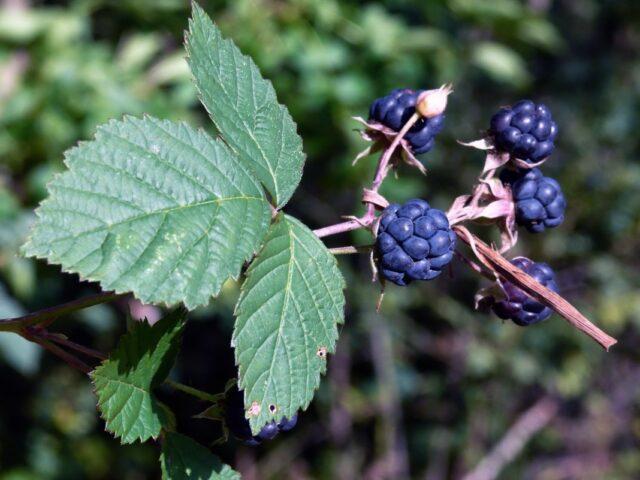
The fruits of the gray blackberry are juicy, aromatic and sweet and sour, but the taste is inferior to other representatives of the genus
Chemical composition
88% of the berries are water, they perfectly quench thirst. The fruits have no fat, per 100 g there are 1.5-2 g of proteins, 4.5-7.5 g of carbohydrates and 25 kcal. Berries are rich in valuable elements:
- vitamins of group B, E, K;
- ascorbic acid;
- carotene;
- tannins;
- ash;
- cellulose;
- organic acids;
- sugars, expressed predominantly by fructose and glucose;
- a set of microelements - manganese, iron, copper, chromium, nickel;
- complex of macroelements - magnesium, calcium, phosphorus, sodium.
Blackberry seeds contain fatty oil. The chemical composition of the leaves is as follows:
- tannins;
- inositol;
- flavonoids;
- acids – ascorbic, organic;
- essential oil.
The roots are rich in essential oil, tannins, starch, tannin and resins.
Application of gray blackberries
Blue blackberries are used in various fields. Thanks to its healing properties, it is used in alternative medicine and cosmetology; its decorative properties make the plant a welcome guest in the garden, and its taste is valued in cooking.Berry juice serves as a permanent dye for cotton and wool, imparting a purple color.
In gardening
Blue blackberries are used to decorate arbors and arches. Its decorative value is due to the large number of fruits collected in clusters and bright green foliage, which turns yellow in the fall.
Bushes strengthen the soil. They are planted for the stability of ravines, slopes, and beams. Blue blackberries are used for breeding to obtain winter-hardy raspberry varieties.
Thorny bushes can be used as a hedge, planted on both sides of a fence or mesh. Another option is to grow on supports to camouflage outbuildings.
In beekeeping
Gray blackberry is a honey plant. 1 hectare of bush can produce up to 20 kg of honey. It is light in color, transparent, and may have a yellowish tint. The aroma is pleasant.
In cooking
Blue blackberries are edible. Its berries can be consumed fresh or prepared in different ways:
- freezing;
- drying;
- preservation - preserves, jams, marmalade, syrups, compotes, juices (extracts).
Young blackberry leaves are used to make surrogate tea.
In folk medicine
Various parts of blackberries - berries, leaves, roots - are endowed with healing properties. The fruits have the following effects:
- restorative;
- anti-inflammatory;
- diaphoretic;
- mild laxative for ripe and astringent for unripe berries;
- antipyretic;
- diuretic;
- calming.

Both fresh and dried blue blackberries are effective in folk medicine.
Gray blackberries help with colds, infections and inflammations, problems with the genitourinary system and gastrointestinal tract.The fruits can be used to strengthen the immune system, prevent vitamin deficiencies and iron deficiency anemia.
The roots are used to prepare a decoction. It is a good anti-inflammatory and diuretic agent. It is used for dropsy, hemorrhoidal bleeding, and kidney diseases.
Decoctions and infusions are made from blue blackberry leaves. The scope of application is wide:
- treatment of gastritis;
- normalization of intestinal motility;
- healing of skin lesions;
- treatment of diseases of the throat and oral cavity - sore throat, pharyngitis, gingivitis, stomatitis;
- anthelmintic effect.
Juice is obtained from fresh leaves, which helps with colds - the temperature decreases and sweating increases. The product is also used externally to treat trophic ulcers, dermatitis, and lichen.
In cosmetology
Blue blackberries are used in the manufacture of cosmetics. It has many useful properties:
- exfoliation of dead cells;
- giving the skin freshness;
- matting effect;
- rejuvenating effect;
- Elimination of earthy complexion.
You can buy cosmetics with blackberries or use the plant at home:
- To freshen the skin, mash the berries, add cream for a creamy consistency. 10-15 minutes after application, remove the composition with a cotton pad soaked in warm green tea, and wash with cool water.
- For oily skin, puree the berries, add honey and lemon juice. Wash off after 20 minutes.
- To rejuvenate, do daily rubbing with berry juice diluted with water.
- To cleanse and tighten pores, apply berry puree without additives.
- The matting effect is provided by young blackberry leaves - they need to be crushed, scalded with boiling water, after cooling, wrapped in gauze and applied to the face. After 20 minutes, remove the lotion, do not wash.
Gray blackberries are good not only for the skin, but also for the hair. To strengthen and thicken hair, rinsing with a decoction of the leaves is effective.
Recipes for various diseases
Gray blackberries help with many diseases. In each case there are certain nuances.
At high temperature
To relieve fever, it is useful to consume fresh blue blackberries or juice from them. You can use frozen fruits, which retain all the benefits.

Blackberry juice is also useful after illness to increase immunity - 50 ml per day is enough
For dysmenorrhea
Blue blackberry leaves will help relieve pain. In addition to these, other medicinal herbs will be required:
- birch, mint leaves;
- buckthorn bark;
- valerian and yarrow - roots.
Take ½ tsp per glass of water. each ingredient. In the evening, put the herbs in a thermos and pour boiling water over it. The next morning, strain, squeezing out the raw materials. Take small sips throughout the day.
For diabetes and gout
Blue blackberries help with such pathologies. You need to grind them, pour boiling water - a glass of 1 tbsp. l. Infuse under a tight lid, strain. Divide into two doses, drink before meals.
For sore throat
Gray blackberry flowers help with a sore throat. Take 1 tbsp per glass of boiling water. l. dried or twice as much fresh raw materials. Leave for an hour and use for rinsing.
Contraindications
Gray blackberries can cause allergies. Sometimes symptoms appear immediately, in other cases they take several hours or even days. The reaction is expressed by nausea, vomiting, swelling of the mucous membranes, and diarrhea.
Eating fresh berries is contraindicated for pathologies of the stomach and small intestine, but drinking juice from them is allowed.In case of high acidity, no more than a glass of the product is allowed per day.
During pregnancy, the use of blackberries should be limited. Abuse of fruits is fraught with allergies, kidney pain, cystitis, and diarrhea. During breastfeeding, berries should be introduced gradually, monitoring the baby's reaction to the new product.
Features of cultivation
Gray blackberries prefer sunny places and are not afraid of light shading. Protection from the north wind and warming up the area are important. The shrub is undemanding to soil; it prefers soddy-podzolic, moderately moist loam. The optimal acidity level is 5-6.5 pH.
Bushes are planted in autumn. The algorithm is like this:
- Make a recess with a side of 0.4 m.
- Add 2 kg of manure, 45 g of phosphorus, and the same amount of potassium.
- Pour 20 cm of soil.
- Place the bush in the hole.
- Cover with soil and compact lightly.
In spring, nitrogen fertilizing is needed. Apply 35-40 g at the base of the bushes. Gray blackberries do not require special care. The activities are simple:
- pruning old dried shoots;
- loosening the soil under the bush - six times per season is enough;
- thinning.

Blue blackberries can be propagated by seeds, root shoots, green cuttings, layering
Collection and storage
Gray blackberry leaves can be harvested all summer, but it is better to choose the flowering period. When cutting, leave cuttings up to 3 cm. Dry the raw materials in the shade outside, in a room with good ventilation or in an oven at 50 °C. The quality of the workpiece is indicated by the preservation of natural color and the absence of brown spots.
The fruits can be dried and frozen. Unripe or overripe berries are not suitable for harvesting; signs of spoilage are unacceptable.Step-by-step drying is recommended:
- In the sun.
- Dry at 30-40 °C.
- Dry at 60°C.
Roots should be dug up in the fall or early spring. The raw materials must be cleared of soil, washed, cut into pieces no larger than 15 cm and dried.
Harvested fruits and leaves are suitable for use throughout the year. The roots can be stored for up to three years.
Conclusion
Gray blackberries grow wild, but they can be cultivated and used in breeding. The shrub is unpretentious to the soil and does not require special care. The berries are edible and have healing properties, as do the roots and leaves.
